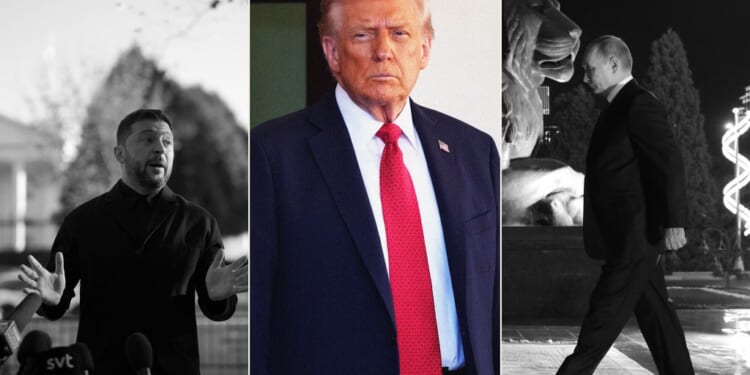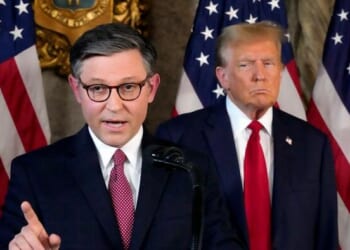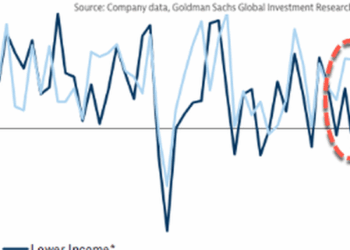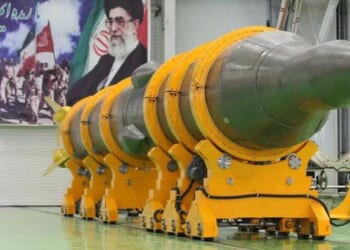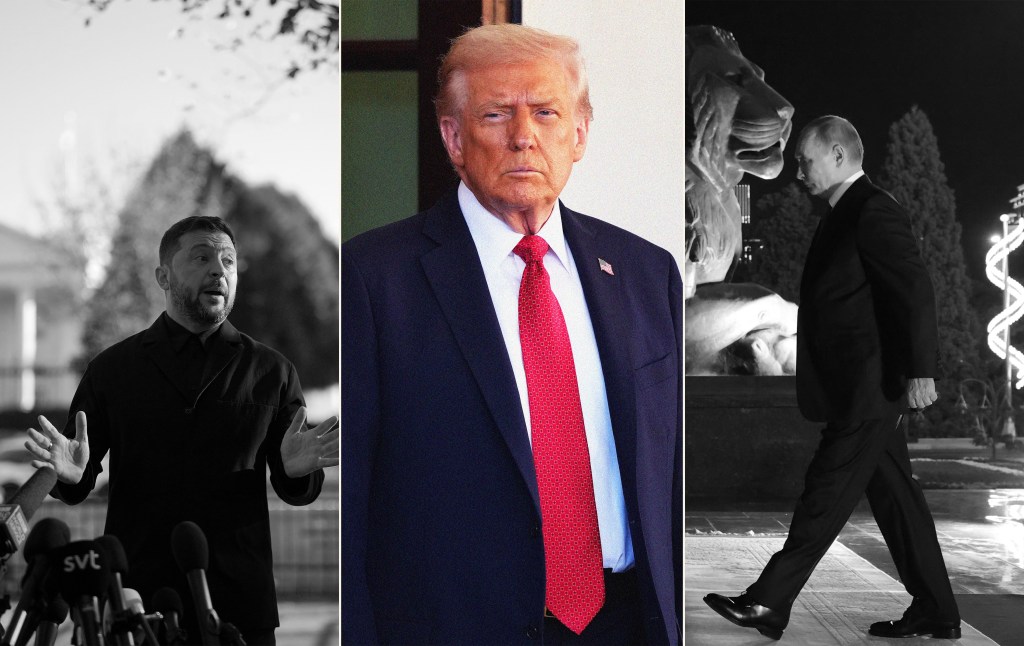
One man started Russia’s brutal, unprovoked war against Ukraine—that’s Vladimir Putin. One man could end Russia’s brutal, unprovoked war against Ukraine—that, too, is Vladimir Putin. One man could help pressure Putin to end Russia’s brutal, unprovoked war against Ukraine—that’s Donald Trump.
Trump’s willingness to do so, however, has oscillated back and forth since last spring’s meltdown with Ukrainian President Volodymyr Zelensky in the Oval Office. Less than a month after saying he believed it was possible for Ukraine to win, Trump has returned to calling for an end to the war, an end that would see the beleaguered nation surrender territory. And last Thursday, he agreed in a phone call with Putin to meet with the Russian president in Budapest—a location that is both favorable to Putin and fraught with haunting memories for Ukraine. Until, that is, the White House indicated on Tuesday that such a meeting is off, for now.
Putin spokesman Dmitry Peskov threw cold water on the idea of an early summit, and Foreign Minister Sergei Lavrov’s initial public statements and private contacts with Secretary of State Rubio reiterated Russia’s long-standing maximalist demands. The White House concluded Tuesday that there was no basis for a summit but that lower-level meetings will continue. Whatever the prospects of a meeting between Trump and Putin are, the latter, at least for now, has tempered Trump’s momentary shift toward Ukraine.
Just one day after the phone call between Trump and Putin, Zelensky went to Washington last Friday hoping to secure American Tomahawk missiles. The Tomahawks on their own wouldn’t necessarily alter the dynamics on the battlefield. But Tomahawks carry larger payloads and fly at faster speeds than long-range Ukrainian-produced drones and would do real damage to Russian military targets and energy and refining facilities, which provide much-needed funds to Russia’s war efforts.
They would also serve as a proportionate response to the escalation of Russian missile and drone attacks on Ukrainian energy and civilian targets that has been evident since just before the Trump-Putin summit in Alaska in August. A decision to provide Tomahawks to Ukraine—likely through an arrangement that Trump skillfully struck with NATO this summer wherein alliance members purchase U.S. weapons and turn them over to Ukraine—would have shown that America’s commitment to Ukraine was solid, despite Putin’s efforts.
The phone call.
Putin, it appears, successfully threw a monkey wrench into those plans. The official Kremlin readout of the phone call the day before Zelensky’s visit to Washington reveals Putin’s praise for Trump’s Middle East efforts and indicates that Trump should have won the Nobel Peace Prize. He also emphasized that Russia was winning in all phases of the war in Ukraine and suggested that providing Tomahawks to Ukraine would have no military effect, while at the same time arguing that taking this step would be highly escalatory. Finally, Putin bemoaned the fact that ongoing U.S.-Russian differences over Ukraine were impeding the many benefits that would flow from an end to sanctions and the resumption of mutually beneficial economic and trade relations.
The Russian side also proposed building a tunnel between Russia and the United States off the coast of Alaska, an idea that Trump even raised during his meeting with Zelensky. All that was apparently enough for Trump to change his mind after indicating earlier last week his willingness to provide Tomahawks to Ukraine. That left Zelensky seemingly empty-handed.
According to a readout of the meeting in the Financial Times, Trump warned Zelensky that Putin would “destroy” Ukraine if it didn’t surrender territory to Russia. The exchange between the two was reportedly more reminiscent of their explosive February 28 meeting, albeit this time without cameras present. According to the Washington Post, special envoy Steve Witkoff (whose previous misunderstandings of Russia’s position led to the failed Alaska summit) reportedly parroted Kremlin talking points when he pressed Zelensky to yield the Donbas to Russia since it is largely inhabited by Russian speakers.
It wasn’t long ago that Trump, after his September 23 meeting with Zelensky on the margins of the U.N. General Assembly, posted, “I think Ukraine, with the support of the European Union, is in a position to fight and WIN all of Ukraine back in its original form. With time, patience, and the financial support of Europe, and, in particular, NATO, the original Borders from where this War started, is very much an option.”
On Friday, Trump argued that Ukraine and Russia should end the fighting where it currently stands. “They should stop where they are. Let both claim victory, let history decide! No more shooting, no more death, no more vast and unsustainable sums of money spent,” Trump wrote on Truth Social. In the part of the meeting open to the press, Trump said, “In my opinion, they should stop the war immediately. … You stop at the battle line, and both sides should go home, go to their families, stop the killing, and that should be it. Stop right now at the battle line. I told that to President Zelensky, I told it to President Putin.”
Asked Monday whether Putin was playing him, Trump answered, “I think he wants to make a deal.” In fact, Putin’s goals haven’t changed: He wants to destroy Ukraine, overthrow its government, subjugate its population, and eliminate its hopes for one day joining NATO. Thanks to the courage and determination of the Ukrainian people, Putin’s goals have been foiled. Now is not the time for the United States to, once again, step back from its support for Ukraine in the futile hope that Putin will see reason and end his military campaign.
After all, the Ukrainians have inflicted more than a million killed and wounded on the Russian side. The Russian economy is feeling the strain of Western sanctions and an overly militarized economy. Russia has seized very little territory since the initial full-scale invasion in February 2022 and has done so at enormous cost.
Ukraine, too, has suffered terribly as a result of Putin’s decisions, but it has reached a point where it produces nearly half of its own military needs. In the case of drone technology and production, Ukraine does that entirely on its own, and its development surpasses any country in NATO. But when it comes to air defense, Ukraine relies heavily on Western—especially U.S.—supplies. The Ukrainian people have proven incredibly resilient in the face of a much bigger enemy that deliberately targets civilian sites, including schools, hospitals, and energy storage facilities in the hopes of freezing the Ukrainian people into submission. Indeed, Russian targeting of Ukraine’s energy grid poses a serious threat to millions of Ukrainians.
Ukraine’s vital contributions to European security.
With or without American Tomahawks and other support, the Ukrainian people will fight on if Putin refuses to stop the bloodshed. They have no choice. Trump and the United States should stand with them. The means by which the U.S. can do so are familiar, but bear repeating: tighten sanctions, work with our allies to seize frozen Russian assets and make them available to Ukraine, pressure countries that are buying Russian oil to stop propping up its energy-dependent economy, and press for the release of all kidnapped Ukrainian children—a cause championed by first lady Melania Trump—and prisoners of war. And finally: provide Tomahawk missiles along with other military assistance.
Since 2014, when Putin illegally annexed the Crimean peninsula and then sent his thugs into the Donbas region, Ukraine has been fighting against Russia’s blatant violation of its sovereignty and territorial integrity. More than 14,000 Ukrainians were killed as a result of Putin’s actions between 2014 and February 24, 2022, when Putin decided to take his invasion of Ukraine to the next level.
In contrast to the Obama administration, which refused to provide lethal military assistance to Kyiv when Putin first invaded in 2014, Trump in December 2017 agreed to provide Javelin missiles, a breakthrough in American backing. Following the full-scale invasion in February 2022, the Biden administration was painfully slow in providing Ukraine with the military assistance it needed. And still Ukraine regained more than 50 percent of the territory Russian forces initially seized, virtually disabled Russia’s Black Sea Fleet, and took the war to Russia itself.
That demonstrated Ukraine’s value as a contributor to European security, not a helpless victim. Were it not for Ukraine’s military capabilities and technological innovations, Russian forces would be threatening other countries in the region, including NATO members. As it is, Russian drones and military jets, among other things, have been testing the alliance, and Moscow has also been waging a dangerous and escalating hybrid war of sabotage and information operations against NATO member states.
Ukraine heroically stands between Russia and the West. It has never asked the West to send men and women to fight its battle. What it has requested—and deserves—are the means to enable its own men and women to defeat the Russian enemy.
In Alaska, Putin received the red-carpet treatment—and followed that up with a significant escalation in missile and drone attacks on Ukraine.
The idea of a U.S.-Russian summit in Budapest, Hungary, which is run by the pro-Russian Prime Minister Viktor Orbán, was bound to conjure up bad memories for Ukraine. It was there, after all, in 1994 that Ukraine agreed to relinquish the nuclear weapons it inherited from the breakup of the Soviet Union in exchange for assurances from Russia, the United States, and Great Britain to respect Ukraine’s sovereignty and territorial integrity.
Russia, of course, violated the terms of the Budapest Memorandum, as the agreement became known, in 2014 with its initial invasion of Ukraine, and the other signatories failed to live up to their end of the deal. The proposed Budapest meeting also discomfited the European allies both because Orbán has been an obstacle to European efforts to support Ukraine and because he has been at loggerheads with EU institutions for years. Fearing that the American side is once again tilting toward Putin, they have jumped into the fray trying to pull Trump back toward support for Ukraine.
In a statement Monday, 12 European leaders, along with Zelensky, underscored the urgency of accelerated support for Ukraine, condemned the acquisition of territory through aggression, commended Trump’s call for a ceasefire in place as the starting point for future negotiations, and called for increased military and economic pressure on Russia. They are also allegedly hard at work on a 12-point plan that would, among other things, put Trump in charge of a board overseeing Ukrainian reconstruction. The Europeans are also moving forward with working out large-scale loans to finance Ukraine’s war effort based on frozen Russian assets. The sooner Ukraine receives that kind of support, the sooner the awful war that Putin started might come to an end. If Trump continues to hesitate in providing the assistance that Ukraine needs, it seems clear that the Europeans are ready to step up and fill the void.

